The ASRock Z97 Extreme6 uses the company's newly-adopted blue and black colour scheme. Part of the package that ASRock entitles Super Alloy are XXL aluminium-based heatsinks.
With the modest power requirements of Intel's LGA 1150-based platform, motherboard heatsinks are largely for aesthetic purposes.
Unlike many of its previous motherboards, ASRock is using a pure black PCB, rather than an ugly shade of brown. This is a smart move by the vendor and one that will please users who desire colour co-ordination of their system.
Four DIMM slots support 32GB of DDR3 memory with speeds of over 3200MHz (CPU dependent). Located next to the 24-pin power connector is one of the Z97 Extreme6's USB 3.0 internal headers.
An LGA 1150 CPU is fed by twelve power phases from ASRock's Super Alloy kit. The power delivery system uses Texas Instruments NexFET MOSFETs, dual-stack MOSFETs, premium alloy chokes, and 12K platinum capacitors.
Starting with the premium alloy chokes, ASRock suggests that the alloy material is able to provide lower power ripple and resistance (hence temperature) compared to a ferrite-based alternative, while also increasing saturation current by 90%.
The NexFET and dual-stack MOSFETs are able to offer higher efficiency and lower temperatures thanks to reduced resistance. Capacitors rated at 12K means that they are able to operate for 12,000 hours at 105°C.
I did some quick back-of-the-envelope calculations of capacitor lifespan when operating temperature is translated to a typical computer environment, and the anticipated duration is far greater than this motherboard will be used for.
Three fan headers, two of which receive a CPU PWM signal, are found along the motherboard's upper edge. This distribution is ideal for users of all-in-one liquid CPU coolers which require three headers for their pump and two fans.
Nestled in its usual location is an 8-pin power connector. Visual inspection of the CPU power delivery system implies that the twelve physical phases are fed by six controllers. In simple terms, one controller is used to operate two physical phases.
The semi-full voltage control configuration seems to be confirmed by the use of an ISL6379 power controller.
Three full-length PCIe x16 slots accompany two PCIe x1 connections on the Z97 Extreme6. Two-card SLI and CrossFire are supported. With its multitude of add-on features, the Z97 Extreme6's lane configuration is particularly tricky.
The first situation is without a drive installed in the Ultra M.2 slot. In this case, the lane configuration for the upper two full-length slots is x16/x0 or x8/x8. The bottom full-length PCIe slot operates via two lanes of Gen 2 bandwidth from the Z97 chipset. That makes the lower slot impossible to use with SLI and practically incompatible with CrossFire.
Bandwidth for the centrally-located mini-PCIe slot is shared with the second-down x1 connection. ASRock calls up an ASMedia ASM1184e PCIe switch to provide four x1 lanes from a single PCIe 2.0 x1 input, when required. This feeds the two ASM1061 storage controllers, the PCIe x1/mini-PCIe slot, and the other PCIe x1 slot.
With a drive installed in the Ultra M.2 slot and stealing four of the CPU's PCIe 3.0 lanes, the upper two full-length PCIe slots operate at x8 and x4 Gen 3 bandwidth, respectively. That makes them compatible with slightly-hampered CrossFire, but not the x8-demanding SLI.
The usual affair of headers is found along the motherboard's bottom edge. An additional USB 3.0 header, internal USB 2.0 port, and power and reset buttons are also provided.
Two M.2 connectors provide Z97 Extreme6 users with plenty of on-board storage options. An M.2 SSD could be installed in the Z97-fed lower M.2 slot, while a higher-speed drive could operate from the 32Gbps Ultra M.2 connection.
Positioning of both M.2 connections is smart. A graphics card will block out a drive's potentially ugly PCB in the upper M.2 slot, and lower one if a multi-VGA configuration is used.
The mini-PCIe slot can be used to install a wireless card, for example. I wouldn't be surprised to see ASRock start shipping a variant with 802.11ac WiFi provided by a mini-PCIe card.
Ten SATA 6Gbps ports are provided on the ASRock Z97 Extreme6 motherboard, six of which operate from the Z97 chipset, while the other four run from two ASMedia ASM1061 host controllers.
Two SATA connections and the additional bandwidth-carrying port combine to form the board's 10Gbps SATA Express port. ASRock's HDD Saver connection can be used to switch off a HDD, allowing power and noise loads to be decreased.
I would like some form of clear differentiation between SATA 6Gbps ports provided by the chipset or ASMedia controllers. ASRock uses board labelling, but some form of colour or physical differentiation would be welcomed.
Realtek's ALC1150 codec provides the foundation for ASRock Purity Sound 2 audio system. EMI shielding and a distinct PCB pathway is used to minimise signal interference.
A pair of Texas Instruments NE5532 op-amps are used to provide support for 600 Ohm headsets, while Nichicon fine gold series capacitors filter the audio signals.
Six USB 3.0 ports, provided via an ASM1074 hub or ASM1042AE host controller, are found alongside multi-channel audio connections and a PS/2 port.
ASRock uses an Intel I218V NIC in addition to a Realtek RTL8111GR chipset. The latter is to be used for ASRock's Cloud software.
DVI (which carries both digital and analogue VGA signals), HDMI, and DisplayPort connections provide video. In close proximity to the video connections are an eSATA 6Gbps connector powered by the ASM1061 controller and a clear CMOS button.
Samsung's XP941 is just about the fastest M.2 SSD on the market. Available for just under £400 in a 512GB variant, the drive is able to operate at speeds of up to 1,170MBps. That makes it ideally suited for testing ASRock's 4GBps-capable Ultra M.2 connection.
Distribution of the Z97 Extreme6 board's six fan headers is excellent. Four are within reach of the CPU socket, while two more are found towards the board's bottom edge, making them well-suited for powering chassis fans.
The Nuvoton NCT6791D controls monitoring and fan speed levels.
 KitGuru KitGuru.net – Tech News | Hardware News | Hardware Reviews | IOS | Mobile | Gaming | Graphics Cards
KitGuru KitGuru.net – Tech News | Hardware News | Hardware Reviews | IOS | Mobile | Gaming | Graphics Cards


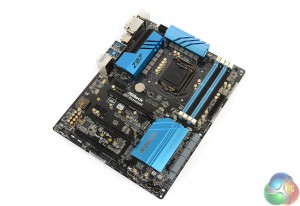
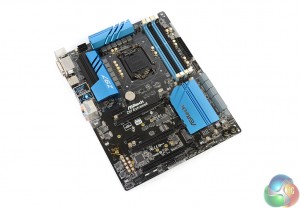
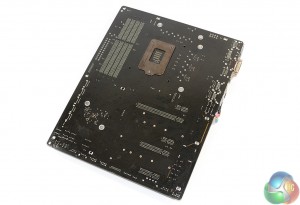
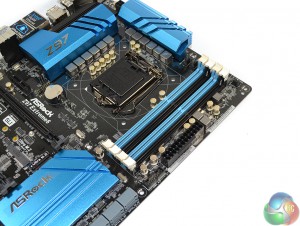
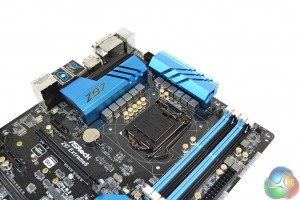
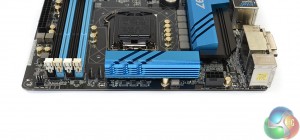
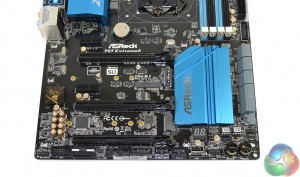
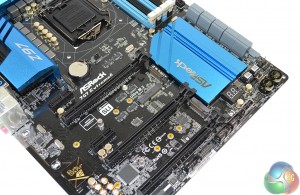
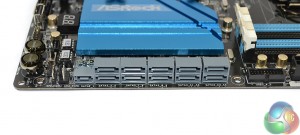
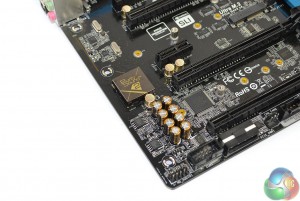
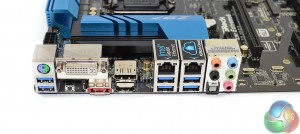
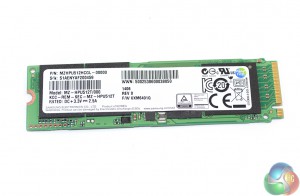
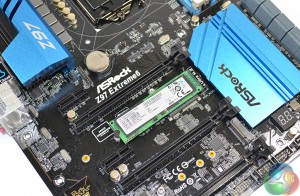
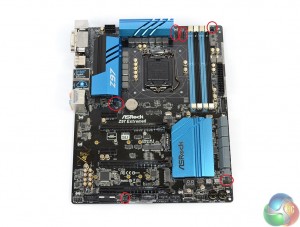
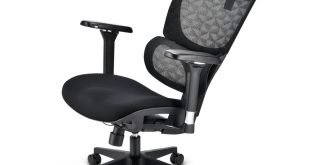
Please review the asrock z97 extreme9. It may eliminate your ONLY con with its PLX chip and greater PCIe capability.
Did you try using the XP941 as a boot drive?
Amazing review! Powerfull board!
Please review the Asrock Z97 Extreme9!!!
Thank you!